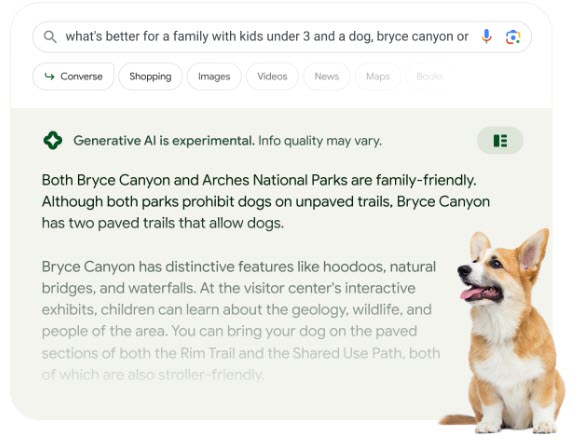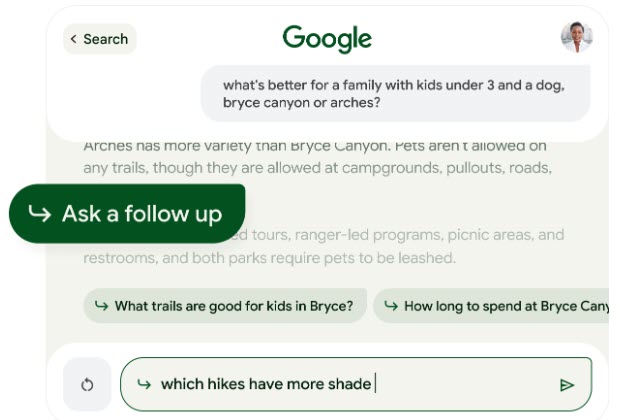Next-Level SEO For Google’s Search Generative Experience
In the ever-evolving search marketing landscape, Google’s Search Generative Experience (SGE) has emerged as a transformative force, reshaping the way users will eventually interact with search results. This paradigm shift presents opportunities for SEOs and digital marketers willing to adapt and optimize their strategies. Let’s dive into some of the intricacies of Google’s SGE, explore how it offers deeper, more personalized answers, as well as provide actionable tactics to help you thrive in this new era.
Understanding Google SGE
It’s an AI-driven initiative designed to provide personalized and conversational responses to user search queries. In other words, as Danny Sullivan is fond of saying, it’s the next step to the Star Trek computer. Utilizing natural language processing (NLP), the Search Generative Experience comprehends complex topics and detailed queries, aiming to replicate the depth of a human conversation. Unlike traditional search, SGE emphasizes conversational queries and featured snippets, presenting AI-generated text that encourages users to spend more time on Search Engine Results Pages (SERPs).


Opportunities Presented by SGE
SGE introduces new ranking opportunities for publishers, in spite of the beliefs that it will lead to an over-abundance of “zero-click” results, robbing publishers of the traffic. Instead of a static featured snippet, SGE provides a comprehensive answer with links to source articles, potentially increasing a website’s visibility and authority. Yes, users are likely to spend more time on SERPs due to the human-like conversational responses generated by SGE, but the only way to get the full answers and context is by clicking-through.
How Marketers Should Prepare for SGE
Move Beyond Traditional SEO Strategies
To thrive in the era of SGE, marketers must evolve their SEO strategies beyond traditional practices. Keyword research and content optimization now require a focus on building topical authority and thought leadership, creating content that offers a unique and valuable experience.
Example: Instead of solely focusing on exact-match keywords, create content that addresses user intent and context. Make it holistic. For instance, if you’re in the fitness industry, develop content around comprehensive workout routines, nutritional guides, and personal success stories, showcasing your expertise and offering a unique, valuable experience.
Pay Closer Attention to E-E-A-T Signals
Elevate your SEO strategy by prioritizing Experience, Expertise, Authoritativeness, and Trustworthiness (E-E-A-T). Demonstrate expertise and experience, engage in authority-boosting activities and leverage subject matter experts in content creation to align with Google’s E-E-A-T standards.
Example: Demonstrate expertise by featuring industry experts in your content. If you’re a financial advisor, publish articles or interviews with certified professionals in finance. Additionally, actively engage in link-building activities by guest posting on reputable sites and obtaining high-quality backlinks from authoritative sources.
Reputation Management Is More Important Than Ever
Optimize for SGE by maintaining a solid online reputation. Positive reviews, active social media presence, and effective online reputation management (ORM) signals to search engines that your content is valuable and trustworthy.
Example: Actively encourage satisfied customers to leave positive reviews on platforms like Google My Business, Yelp, or industry-specific review sites. Respond promptly to negative reviews, addressing concerns and showcasing your commitment to customer satisfaction. Maintain an active and positive social media presence to enhance your brand’s credibility.
Create Comprehensive Internal Linking Architectures
As we’ve already mentioned, create in-depth, authoritative content, AND strategically build internal links to enhance content authority and credibility. This is your chance to use more targeted, category-driven anchor text to help build the link graph, as opposed to more brand-driven anchors.
Example: Create comprehensive, in-depth guides on key industry topics. If you’re in the technology sector, produce detailed analyses of emerging trends, technologies, and their implications. Actively share this content across relevant platforms, positioning your brand as the authoritative source for in-depth industry insights.
Dive Into Your Data and Analytics
Agility is key. Constantly evaluate and adjust your SEO content strategy and approach based on data analysis to refine, optimize, and create new workstreams of content that more fully drive topical authority and answers user’s need more succinctly.
Example: Regularly analyze website and content performance using analytics tools. If a particular type of content or keyword strategy isn’t yielding desired results, be quick to pivot. Experiment with different content formats, promotional strategies, or even adjust your publishing frequency based on real-time data insights.
Optimize for Long-Tail Queries
Recognize the significance of long-tail queries in SGE. While this should be happening almost naturally as you write content, sometime you’ll have to be deliberate to create and optimize content specifically for question-based queries. SGE personalized answers often stem from such inquiries.
Example: Identify specific long-tail queries relevant to your industry or niche. If you’re in the travel business, create content that answers detailed questions like “Best budget-friendly vacation spots for families in Europe.” Optimize this content with clear, concise answers to cater to the conversational and personalized nature of SGE.
Embrace Experimentation
Experiment with innovative ideas to identify what resonates best with your audience. From user-generated content to personal branding tactics, explore various strategies to engage users effectively. Experiment with different content formats, such as video, infographics, or interactive elements. None of these are new, but somehow consistently get lost in the wake of time. Make sure to resurface them to present information in a clear, easy-to-digest way.
Monitor audience engagement metrics to identify which formats resonate best. Additionally, encourage user-generated content, such as reviews, testimonials, or user-contributed stories, to enhance authenticity and engagement.
Example: Incorporate personal anecdotes and experiences into your content. If you’re in the health and wellness industry, share personal success stories or challenges you’ve overcome. Use conversational language and address follow-up questions naturally within the text, providing a human touch to your content that AI can’t replicate (yet).
Embracing Google’s Search Generative Experience doesn’t signify the end of traditional SEO; rather, it marks the beginning of a new and promising chapter. By adapting strategies, paying attention to E-E-A-T signals, managing reputation effectively, owning industry narratives, being agile, optimizing for long-tail queries, and embracing experimentation, marketers can position themselves for success in this evolving digital landscape. The future is bright for those who approach SGE with optimism, ready to explore the opportunities it presents for boosting rankings, driving traffic, and increasing revenue.
